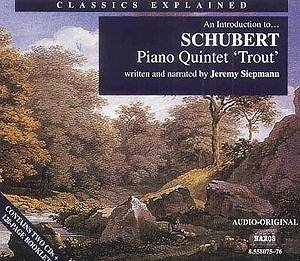These two well filled CDs are an attempt to explore
one of the major classical works 'in an accessible and lively manner'.
The discs consist of a spoken narration (written and narrated by Jeremy
Siepmann) interspersed with musical examples taken from the Naxos CD
of the Trout Quintet. Jeremy Siepmann's text is written with an admirable
lack of jargon. But to understand the first movement of the Trout Quintet
properly, one needs to know about classical sonata form. An important
factor in the movement is the way Schubert plays with our expectations
(based on classical sonata form) and then confounds them. During the
exposition, Siepmann does take time out to illustrate Schubert's lack
of modulation between key changes. But it is not until the end of the
exposition that we get a discussion about key relationships. This means
that early on a comment about E major being the Dominant of A major
goes past without explanation. Also at this point, we get a discussion
about what a development is (in the context of sonata form) and by the
end of the movement we have a clearer idea about sonata form. But I
cannot help feeling that it would have been useful putting some of this
up-front in an introductory track. This might have seemed slightly fearsome
and didactic to the uninitiated listener, but it would have prepared
them for the discussion. An added advantage would have been that the
experienced listener could skip over these tracks. A lot of this information
is included in the excellent booklet, including a definition of Sonata
form, but I could not find the definition of Dominant anywhere.
The actual introduction itself starts with an excerpt
from the Scherzo which seems rather an odd way to begin things. It made
me wonder if I had put the correct CD on. Siepmann's text is liberally
sprinkled with musical excerpts from the complete performance of the
quintet and from other pieces. This is extremely helpful, but what is
lacking is the provision of incomplete musical examples (e.g. a sample
of an individual player’s part). This means that we are reliant on Siepmann's
description and our ability to distinguish what he has been talking
about when listening to the complete excerpt. It would have been extremely
useful, when talking about Schubert's complex textures, to be able to
hear individual parts in isolation.
Jeremy Siepmann's informative narration is both lucid
and entertaining, it wears its learning lightly and has a nice line
in understated humour. By the time you have reached the end of these
two admirable CDs you know a lot more about the structure of the Trout
Quintet, without ever having felt you have been lectured to.
The extensive booklet contains the complete text spoken
by Jeremy Siepmann plus various informational chapters on the Historical
Background; a Biographical Sketch of Schubert; the place and importance
of the Trout Quintet in Schubert's output; a structural overview - an
excellent description of the structure of each movement; the Role of
the Interpreter; The Art of the Listener; What Music is; What Music
is Not: Music and Snobbery; A Brief Guide to the Composer's Tools -
useful compendium of all the things that the more experienced listener
might take for granted including descriptions of the standard instruments;
The Basic Forms of Music - which includes a very lucid paragraph on
Sonata Form; and finally a Glossary. Despite some rather high-flown
language, much of this is useful and interesting - basics which one
can often take for granted, especially in the Role of The Interpreter
and the Art of the Listener chapters, though the author does
take one or two rather barbed side-swipes at performers. The draw back
is that much of this material is generic, not specifically applicable
to the Trout Quintet. So if you have more than one of these 'An Introduction
to…' sets, then you will have read some of this information already.
The CD booklet thus contains all the information a
listener might need to understand the text and the illustrations. So
to get the best from this set you must be prepared to use the booklet
to read around the subject before listening. perhaps stop and look things
up whilst listening the first time, and definitely listen more than
once.
For the experienced user this set can prove an interesting
illustrated lesson about the Trout Quintet and as such I found it very
helpful. The performances, taken from the Naxos recording by Kodaly
Quartet with Jeno Jando and Istvan Toth, are excellent. The disc also
has excerpts from other works, including a performance of the original
Schubert song.
But whether the listener was a novice or quite experienced,
there will come a time when they are satisfied that they have learned
all they can from this CD. What next? This is not really a set to sit
on the library shelves to be taken down occasionally; the different
movements are separated by the text, so that it is not easy to use these
CDs to listen to a complete performance. This is very much to be shared
or borrowed. But for anyone wanting to listen to classical music with
a more informed ear, this is an excellent place to start.
Robert Hugill

